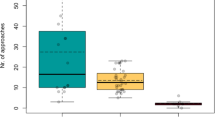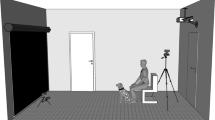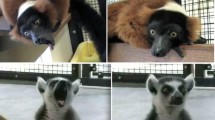Abstract
Captive prosimians housed in a semi-natural laboratory environment were exposed to novel stimuli, both animate (cat, snake) and inanimate (empty box). Observations were made by means of closed circuit TV. Animate stimuli elicited considerably more interest (about 42% of a test session) than the inanimate stimulus (about 12% of the test session). The more vulnerable species, the slow loris, displayed as much curiosity as the less vulnerable species, the greater galago; but, in the presence of live stimuli, lorises were more cautious. They moved slowly and silently, employed contact as a mode of investigation significantly less often than galagos, spent significantly less time than galagos investigating from within 3 ft, took significantly longer than galagos to make their first approaches to within the 3 ft zone, and, once there, stayed for significantly shorter visits than galagos. The data demonstrate: (1) that prosimians are highly responsive to novelty if the stimuli are appropriate; and (2) that it is important to take into account not just whether animals investigate but also how they investigate.
Similar content being viewed by others
References
Bishop, A., 1964. Use of the hand in lower primates. In:Evolutionary and Genetic Biology of Primates, Vol. 2,J. Buettner-Janusch (ed.), Academic Press, New York, pp. 133–225.
Charles-Dominique, P., 1977.Ecology and Behaviour of Nocturnal Primates. Columbia Univ. Press, New York.
———— &S. K. Bearder, 1979. Field studies of lorisid behavior: methodological aspects. In:The Study of Prosimian Behavior,G. A. Doyle &R. D. Martin (eds.), Academic Press, New York, pp. 567–629.
Doyle, G. A., 1974. Behavior of prosimians. In:Behavior of Nonhuman Primates, Vol. 5,A. M. Schrier &F. Stollnitz (eds.), Academic Press, New York, pp. 1–142.
Ehrlich, A., 1970. Response to novel objects in three lower primates: greater galagos, slow loris and owl monkey.Behaviour, 37: 55–63.
————, 1977. Social and individual behaviors in captive greater galagos.Behaviour, 63: 192–214.
———— &A. Musicant, 1977. Social and individual behaviors in captive slow lorises.Behaviour, 60: 192–220.
Glickman, S. E. &R. W. Sroges, 1966. Curiosity in zoo animals.Behaviour, 26: 151–188.
Jaenicke, C. G. &R. W. Acosta, 1978. Curiosity-fear in a nocturnal prosimian. Paper presented at meeting of Southwest. Anthropol. Ass., San Francisco.
Jolly, A., 1964. Prosimians' manipulation of simple object problems.Anim. Behav., 12: 560–570.
Keppel, G., 1973.Design and Analysis: A Researcher's Handbook. Prentice-Hall, Englewood Cliffs, New Jersey.
Menzel, E. W., 1966. Responsiveness to objects in free-ranging Japanese monkeys.Behaviour, 26: 130–150.
Russell, E. M. &G. A. Pearce, 1971. Exploration of novel objects by marsupials.Behaviour, 40: 312–322.
Welker, W. I., 1956. Some determinants of play and exploration in chimpanzees.J. Comp. Physiol. Psychol., 49: 84–89.
Wilson, C. C., 1972. Spatial factors and the behavior of nonhuman primates.Folia Primatol., 18: 256–275.
Wolin, L. R., J. M. Ordy &A. Dillman, 1963. Monkeys' fear of snakes: a study of its basis and generality.J. Gen. Psychol., 103: 207–225.
Author information
Authors and Affiliations
About this article
Cite this article
Jaenicke, C., Ehrlich, A. Effects of animate vs. inanimate stimuli on curiosity behavior in greater galago and slow loris. Primates 23, 95–104 (1982). https://doi.org/10.1007/BF02381441
Received:
Accepted:
Issue Date:
DOI: https://doi.org/10.1007/BF02381441




